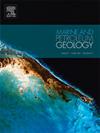Deciphering the dynamic evolution of the South Caspian Basin: Insights from channel patterns of the Amu Darya Delta
IF 3.7
2区 地球科学
Q1 GEOSCIENCES, MULTIDISCIPLINARY
引用次数: 0
Abstract
This research investigates the South Caspian Basin's (SCB) tectono-sedimentary evolution by analyzing submarine channel geometry and azimuth, seismic stratigraphy, and data from a recent exploration well in the basin center. The SCB is a unique basin due to its significant tectonic activity, large sediment supply from surrounding mountain ranges, and complex geological history. It is also a critical region for hydrocarbon exploration, with substantial petroleum resources concentrated in its Pliocene strata. Understanding the SCB is crucial as it provides insights into how similar basins fill and evolve over time. Using enhanced 3D seismic data, multiple horizons are mapped to reveal channels. Thickness maps and reflector patterns help identify the Amu Darya Delta paleo-shelf breaks at the basin's eastern margin. Basin disconnections and reconnections are marked by an angular unconformity (∼3.4 Ma) and two maximum flooding surfaces (∼2.75 and ∼1.76 Ma). Subsidence curves of one well indicate significant tectonic subsidence and high sediment supply from the nearby mountains, resulting in a deep isolated present-day basin. The Amu Darya shelf break has been prograding southwestward with a northward shift of the Amu Darya River as its main channel since the mid-Pleistocene considering the channels and Gross Depositional Environment (GDE) maps. The channel patterns reveal different stages of delta development.
求助全文
约1分钟内获得全文
求助全文
来源期刊

Marine and Petroleum Geology
地学-地球科学综合
CiteScore
8.80
自引率
14.30%
发文量
475
审稿时长
63 days
期刊介绍:
Marine and Petroleum Geology is the pre-eminent international forum for the exchange of multidisciplinary concepts, interpretations and techniques for all concerned with marine and petroleum geology in industry, government and academia. Rapid bimonthly publication allows early communications of papers or short communications to the geoscience community.
Marine and Petroleum Geology is essential reading for geologists, geophysicists and explorationists in industry, government and academia working in the following areas: marine geology; basin analysis and evaluation; organic geochemistry; reserve/resource estimation; seismic stratigraphy; thermal models of basic evolution; sedimentary geology; continental margins; geophysical interpretation; structural geology/tectonics; formation evaluation techniques; well logging.
 求助内容:
求助内容: 应助结果提醒方式:
应助结果提醒方式:


